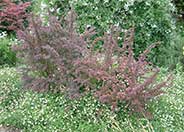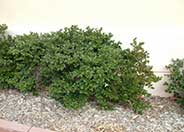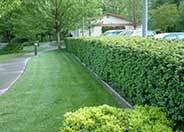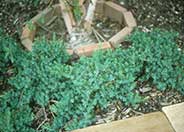
Common name:Red Leaf Japanese Barberry
Botanical name:Berberis thunbergii 'Atropurpurea'
A thorny, deciduous shrub growing 4'-6' high and as wide, Red Japanese Barberry can be contained with some light pruning. Its purplish-red leaves contrast beautifully against a dark green background.

Common name:Natal Plum
Botanical name:Carissa macrocarpa
The Natal Plum is a shrub that quickly reaches 2'-7' tall and 10' wide. Stems have thorns. The plant produces a milky sap that may cause allergenic reactions for some folks. Leaves are leathery, glossy and dark green. White, fragrant star shaped flowers bloom in spring, followed by egg shaped fruit that turns red when ripe. Fruit tastes like cranberries! This shrub takes little water once it's established and tolerates heat. It's great for barrier hedges.

Common name:Frades or Compact Escallonia
Botanical name:Escallonia 'Frades'
The 'Frades' is an evergreen shrub that grows to 6'-8' tall and wide. It is valued for its glossy foliage and clusters of pink flowers. The heaviest bloom period is during spring and fall, with some flowers all year. The Escallonias grow best in sun to part shade, but will tolerate mostly shade if necessary. These plants usually need little or no summer watering. This is the most tolerant of poor drainage of all Escallonia varieties. -Monterey Bay Nursery

Common name:Blue Pacific Shore Juniper
Botanical name:Juniperus rigida conferta 'Blue Pacific'
This is the improved form of the Juniperus conferta, as the growth of this variety is more compact, with foliage that is a rich, blue-green color. Junipers are highly combustible plants.

Common name:Pony Tail or Bottle Palm, Beaucarne
Botanical name:Nolina recurvata
This palm-like shrub from the Agave family has a single trunk and grows up to 30' tall. It has thin flat leaves that can grow up to 6' long and only 1" wide. The base is large and distinctive; it usually looks swollen. Mature plants may bloom on a 3'-4' tall stalk.
Designer: Pam Pavela
Photographer: GardenSoft
Practice grass-cycling by leaving short grass clippings on lawns after mowing, so that nutrients and organic matter are returned to the soil.
Drip and other smart irrigation delivers water directly to roots, allowing no excess water for weeds.